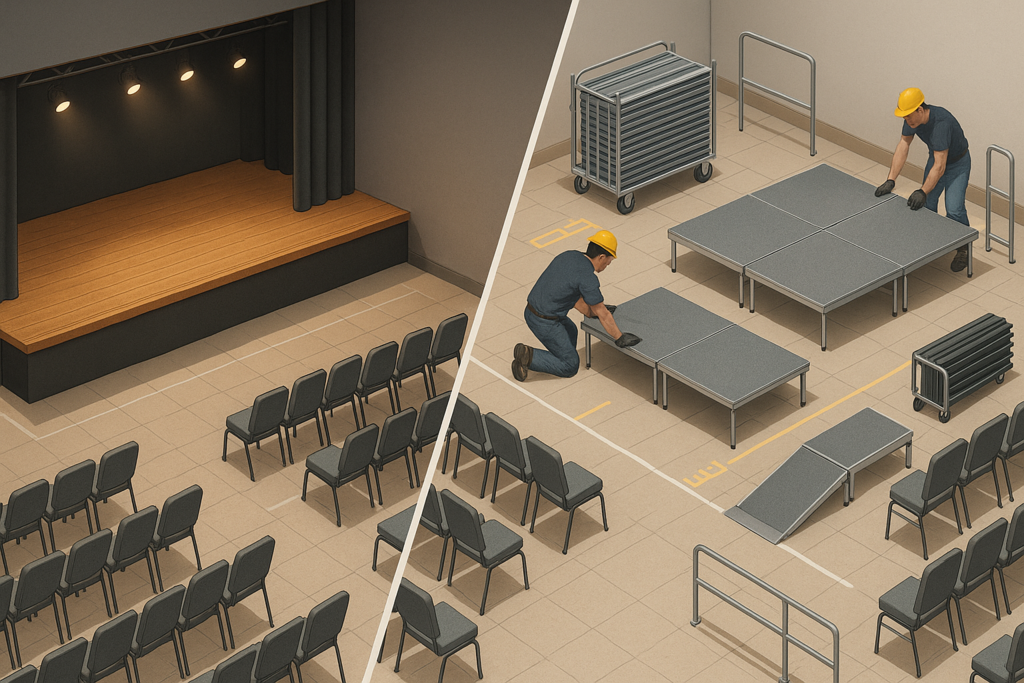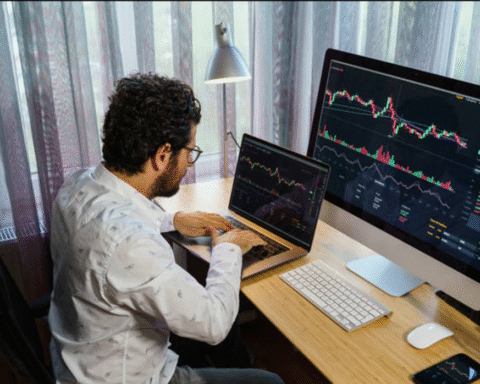Deciding between a concert stage and a portable stage is, at heart, a financial decision shaped by space, staffing, safety, and programming needs. Small venues—from clubs and community theaters to churches and campus halls—operate with tight budgets and variable calendars. A clear return-on-investment framework helps you weigh initial spend against revenue, labor, storage, and risk over time.
The ROI lens: what to measure
A practical ROI model for a small venue should include five pillars: acquisition cost, useful life, labor and setup time, storage and transport, and revenue impact (seat count, ticket tiers, rentals, and sponsorships). Alongside these, factor in compliance, insurance, and the effect on audience satisfaction. The goal is to move beyond sticker price and chart how the platform contributes to repeat events, fuller houses, and smoother turnarounds.
Upfront cost vs total cost of ownership
A permanent Performance stage often means higher up-front expense due to engineering, carpentry, finishes, and possible permitting. Payback depends on frequent use and the ability to command better ticket prices and higher bar or concession sales. A Mobile stage typically costs less to acquire and install, but accessories, transport cases, and ramps add to the bill. The total cost of ownership should roll up everything you will spend across five to ten years: repairs, replacements, accessories, and any storage or vehicle needs.
For many small venues, the question is not only “What can we afford today?” but “Which option keeps cash flow steady?” If programming is seasonal or sporadic, a Modular stage that can be redeployed as risers, camera platforms, or side wings can distribute value across varied uses, shortening payback. If the calendar is packed with live acts every week, a built-in Event stage may justify its higher initial outlay by cutting setup time and supporting consistent seat maps that lift revenue.
Labor, time, and staff fatigue
Labor is a hidden line item that often swings the decision. Fixed platforms generally require little day-to-day effort—cleaning and light maintenance—while a Mobile stage can be set up and struck by a small crew. The difference is cumulative. If you host three shows a week and spend 60–90 minutes moving decks, placing skirts, and leveling legs, those hours become real money and fatigue by year’s end.
The trade-off is flexibility. A Modular stage empowers you to reconfigure for spoken word on Thursday, a trio on Friday, and a dance showcase on Saturday. If variety is your business model, the extra minutes per show may be worth the agility. Conversely, if your format rarely changes, a fixed footprint saves labor and reduces the chance of errors during fast turnarounds.
Storage, transport, and space economics
Small venues live and die by square footage. A fixed Event stage claims space permanently; you recoup that floor area only if the platform allows for meaningful backstage storage or if the footprint enables higher ticket classes and better sightlines that lift revenue. A Mobile stage demands storage when not in use. Measure the true cost of that closet or room—rent, opportunity cost, and the hassle of moving cases through narrow hallways or elevators.
Transport is another lever. If your venue supports off-site shows, a Modular stage can create new income streams by renting to partner events or producing pop-ups. That opportunity exists only if you can move the decks in a van, and if staff have a repeatable loading plan. If you operate in a single room with no satellite work, transport value may be negligible.
Safety, compliance, and risk
Safety is non-negotiable. Insurers and local authorities look for guardrails, toe-kicks, non-slip surfaces, load ratings, and ramp slopes within guidelines. A built-in Performance stage can be engineered once and inspected, minimizing day-to-day guesswork. A Modular stage requires disciplined checklists: verify leg locks, connectors, and level; place railings and ramps; confirm anchors on irregular surfaces. The payoff is adaptability, but it comes with responsibility.
Risk has a cost. Claims, downtime, and reputation damage erode ROI quickly. If your staff churn is high or volunteers handle setup, simpler, foolproof hardware with clear labeling can be worth paying for. If you maintain a steady, trained crew, you can bank the efficiency of faster builds and more complex layouts.
Audience experience and revenue per seat
The platform affects sightlines, acoustics, and the feel of the room. A thoughtfully designed Event stage can raise the front row, reduce blocked views, and improve perceived production quality. That, in turn, can support tiered pricing, VIP areas, and repeat attendance. A Mobile stage can do the same when configured with the right height, skirt finish, and ramp placement, especially when you need to push the platform deeper or wider for larger acts.
The trade-off emerges in multi-use rooms. Schools and houses of worship often need flat floors for day events and raised platforms at night. A Modular stage shines here, letting you preserve flexible seating charts and community programs. If the audience expects a consistent theater feel, a permanent footprint might better protect per-seat value.
Programming flexibility and calendar utilization
Revenue is strongly tied to how many dates you can book and how fast you can change over. A fixed Performance stage accelerates changeovers for similar shows, powering dense calendars. A Modular stage extends your booking options: fashion shows this week, a comedy festival next, and a choir after that. Flexibility can attract rentals from promoters who need custom footprints or additional risers for front-of-house and cameras.
The challenge is decision fatigue and planning overhead. More layout choices mean more advance work. Templates address this: create three standard stage maps—small, medium, large—each with predefined deck counts, riser heights, and ramp positions. Price them clearly for renters. You gain the upsides of versatility without the chaos of constant custom builds.
Maintenance and lifespan
A fixed Event stage benefits from durable materials and finishes suited to daily wear. Scuffs and repairs are localized, but certain upgrades—such as changing fascia or adding proscenium elements—can be costly. A Modular stage spreads wear across multiple decks; individual components can be replaced without touching the rest of the system. The counterpoint is inspection discipline, as more parts mean more potential failure points if neglected.
Lifespan should be estimated conservatively. For a Mobile stage used weekly, plan for periodic hardware refreshes, replacement of non-slip surfaces, and the occasional bent component from transport bumps. For a permanent platform, budget for refinishing and structural checks every few years. Tying these cycles to your cash flow prevents surprise capital hits.
Financial modeling: a simple path to clarity
Start with a one-page worksheet covering three scenarios: low, medium, and high utilization. List the acquisition cost; add accessories; include a reserve for maintenance. Estimate labor minutes for setup and strike; multiply by a realistic hourly rate with a buffer for overtime. Add storage or transport costs if relevant. Project revenue changes: more seats, higher ticket classes, and potential rentals to outside groups. Include insurance deltas if your provider gives different rates based on platform type or safety features.
Then set a payback target—often two to three years for small venues—and calculate how many events it will take to reach it under each scenario. If a built-in Performance stage reaches payback in 18 months at your expected booking pace, it is a strong candidate. If the numbers only work in the most optimistic case, keep looking or consider a phased purchase where you start with a Modular stage and later add permanent elements.
Branding, sponsors, and secondary revenue
Staging can carry sponsor panels, skirting with logos, and LED surrounds that push ancillary revenue. A fixed Event stage makes repeat placements easy and consistent for long-term partners. A Mobile stage can be fitted with removable fascia for touring sponsors or seasonal campaigns. The challenge lies in maintaining a clean look while keeping surfaces easy to swap between events. A small venue can sell these placements as part of a tiered package that also includes lobby signage and digital mentions, turning the platform into a predictable income source.
Accessibility and community impact
Accessibility is both a legal duty and a community promise. Ramp angles, clear paths, and adequate side space affect how performers and guests experience the room. A permanent Performance stage lets you build generous wings and integrated ramps with consistent slopes. A Modular stage allows you to set temporary ramps exactly where needed for each show, which helps in tight rooms but demands vigilance in layout reviews.
Community impact goes further. If your venue hosts civic meetings, school awards, or faith gatherings, the ability to set up quickly and safely, then clear the room for other uses, can build goodwill and repeat bookings. The right platform supports not just revenue, but your role in the local arts and events scene.
Environmental and noise considerations
Material choices, transport miles, and setup practices all carry environmental and neighborhood effects. A permanent Event stage avoids repeated hauling but locks in materials for years. A Modular stage may travel but can be re-used across many contexts, which can reduce waste from temporary builds. Noise during load-in and load-out matters in mixed-use areas. Quieter, well-planned assembly during reasonable hours protects neighbor relations. These factors rarely appear on the balance sheet, yet they influence permits, partnerships, and long-term tenancy.
Common challenges and how to handle them
Two challenges appear frequently. First, mismatch between stage size and actual bookings. Venues sometimes oversize a platform, cutting seat count without meaningful gain for performers. Pilot your layout for a month; track sightlines, backline needs, and audience feedback before committing to carpentry. Second, inconsistent crew methods. Even with an easy Modular stage, skipping a leveling step or misplacing a ramp angle creates safety issues and slows the next build. Solve this with laminated checklists, labeled cases, and short training videos stored on a shared drive.
A third challenge arises when the venue grows. What begins as a tidy Mobile stage can become a patchwork of add-ons. Set thresholds in advance: when events exceed a certain deck count or when you add wings and FOH risers every week, evaluate a hybrid plan—a modest permanent platform plus a small Modular stage kit for add-ons. This maintains order and protects ROI.
Choosing between fixed, mobile, or hybrid
A fixed Performance stage fits venues with stable formats, frequent bookings, and a clear brand around live shows. It keeps labor low and improves day-to-day consistency. A Mobile stage fits venues that rent out their room for varied events, tour to satellite spaces, or run on volunteer crews who can follow simple, repeatable builds. A hybrid approach—a modest permanent platform for the core footprint plus a small Modular stage package for risers and extensions—often balances both worlds. You get dependable shape and the freedom to scale for bigger nights.
Putting it all together: a decision roadmap
Start by mapping your calendar for the next twelve months. Group events by footprint needs: small, medium, large. Count the likely shows in each group. Assign ticket prices and expected attendance. Draft two or three standard layouts that match those groups. Price them against each platform choice and run the math. Add the soft factors: training time, storage constraints, sponsor plans, compliance comfort, and community expectations. If one path wins across most categories and stays inside your payback window, you have your answer. If results are mixed, the hybrid route usually closes the gap without overcommitting capital.
Final thoughts
Return on investment for staging is not only about the platform under the performers. It is about the calendar you can fill, the labor you can sustain, the seat map you can support, and the trust you build with audiences, artists, insurers, and neighbors. A permanent Event stage leans into consistency and speed. A Modular stage leans into flexibility and new revenue paths. The best choice is the one that keeps your room working hard across the year, protects people, and leaves you with the financial headroom to say yes to the next booking that could put your venue on the map.








